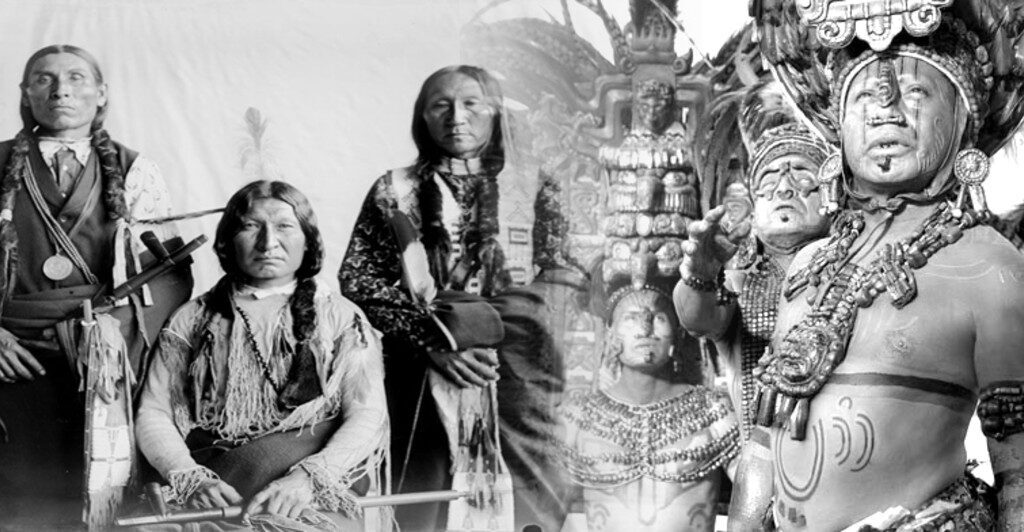
Introduction:
When we think of the discovery of America, the image of Christopher Columbus setting sail in 1492 often comes to mind, accompanied by tales of adventure and exploration. However, this narrative is but a fragment of a much richer and more complex tapestry. Long before Columbus’s ships graced the shores of the New World, the Americas were alive with vibrant cultures, thriving societies, and intricate civilizations that had flourished for thousands of years. Imagine vast cities built from stone, bustling trade routes connecting diverse peoples, and sophisticated agricultural practices that fed millions. Picture the wisdom of indigenous leaders, the artistry of their crafts, and the spiritual connections they maintained with the land. The story of America’s discovery is not merely one of European exploration; it is a profound saga of resilience, innovation, and the enduring spirit of those who called this land home long before it was “discovered.” As we delve into the untold story of the discovery of America, we will uncover the rich histories of the indigenous peoples who navigated these lands, the complexities of their societies, and the legacies they are left behind. This is a journey that transcends time and challenges us to rethink our understanding of history—a narrative that deserves to be told. Join us as we explore the vibrant cultures and remarkable achievements of the Americas before Columbus, revealing a past that is as captivating as it is essential to our understanding of the present.

The Untold Story of the Discovery of America refers to the history of the Americas before the arrival of Christopher Columbus in 1492. It challenges the traditional narrative that Columbus “discovered” America by highlighting the fact that the Americas were already populated by millions of indigenous people with advanced civilizations
Some key points about the untold story:
- Indigenous creation stories tell of how their ancestors arrived in the Americas thousands of years ago, either by crossing a land bridge from Asia or by ocean voyages4. Archaeological evidence suggests humans first arrived between 18,000-20,000 years ago4.
- By 1491, the indigenous population in the Americas numbered in the tens of millions. They had mastered hunting, fishing, and agriculture, and developed sophisticated societies with architecture, astronomy, philosophy, science, art, and trade networks spanning two continents.
- Indigenous architectural styles reflected their diverse environments, from ice houses in the Arctic to adobe apartment buildings in the Southwest. Maize, sweet potatoes, beans and cacao were cultivated and spread via trade.
- Complex systems of governance, from patriarchal to matrilineal societies, controlled citizens and multi-nation empires. Scientific innovations included mapping planets, multi-year calendars, and writing systems.
- Despite 500 years of pressure to assimilate, indigenous culture has endured and been reclaimed through preservation of language and material culture.
How did Indigenous Peoples of the Americas develop their Sophisticated Societies?
Indigenous peoples of the Americas developed sophisticated societies through a combination of environmental adaptation, agricultural innovation, social organization, and cultural practices. Here are some key factors that contributed to the sophistication of these societies:
Environmental Adaptation
Indigenous groups adapted to diverse environments across the Americas, from the Arctic tundra to tropical rainforests. This adaptability allowed them to utilize local resources effectively, whether through hunting, gathering, fishing, or farming.
Agricultural Innovation
Agriculture was a cornerstone of many indigenous societies. They cultivated a variety of crops, including maize, beans, and squash, often referred to as the “Three Sisters.” These crops were not only staples of their diets but also formed the basis for complex agricultural systems. For instance, the Inca civilization developed advanced techniques for irrigation and terracing, enabling them to farm in the challenging Andean mountains.
Social Organization
Many indigenous societies were organized into complex political structures, including chiefdoms, city-states, and empires. These systems facilitated trade, governance, and social cohesion. For example, the Maya civilization had a well-defined hierarchy and engaged in extensive trade networks that connected various city-states across Mesoamerica.
Cultural Practices
Rich cultural traditions, including art, music, and spirituality, played a significant role in the development of indigenous societies. These practices fostered a sense of identity and community, reinforcing social bonds and shared values. Many indigenous peoples maintained extensive oral histories that preserved their knowledge and traditions across generations.
Knowledge Systems
Indigenous peoples possessed sophisticated knowledge of natural resources, including medicinal plants and sustainable land management practices. This knowledge was crucial for their survival and contributed to their ability to thrive in various environments. For example, many groups developed extensive botanical knowledge, which allowed them to cultivate and utilize a wide range of plants for food and medicine.
Trade and Interaction
Trade networks were integral to the economic and cultural development of indigenous societies. These networks facilitated the exchange of goods, ideas, and technologies, enhancing the sophistication of their societies. The Mississippian culture, for instance, created large urban centers like Cahokia, which became hubs for trade and cultural exchange.
Technological Evolutions of The Native America
The technological evolution of Native Americans is marked by significant innovations and adaptations that reflect their deep understanding of their environments and their cultural practices. Here are some key areas of technological development among indigenous peoples of the Americas:
1. Agricultural Innovations
Native Americans were pioneers in agriculture, developing techniques that allowed them to cultivate a variety of crops.
- Three Sisters Planting: This method involved growing maize, beans, and squash together, which complemented each other’s growth and provided a balanced diet.
- Irrigation Systems: Civilizations like the Hohokam in the Southwest created extensive irrigation canals to support agriculture in arid climates.
2. Transportation Technologies
Indigenous peoples developed various means of transportation suited to their environments.
- Canoes: Many tribes crafted canoes from trees, allowing for efficient travel and trade across rivers and lakes.
- Sleds and Dog Teams: In Arctic regions, sleds pulled by dogs were essential for transportation over snow and ice.
3. Construction Techniques
Native Americans built structures that reflected their environmental conditions and social needs.
- Tipis: Used by Plains tribes, these portable dwellings were well-suited for a nomadic lifestyle, easily assembled and disassembled.
- Longhouses: Northeastern tribes constructed longhouses that housed multiple families, showcasing communal living and resource sharing.
4. Cultural and Artistic Innovations
Technological advancements also extended to cultural expressions.
- Textiles and Weaving: Native Americans created intricate textiles, using natural fibers and dyes to produce clothing and ceremonial items.
- Pottery: Many tribes developed advanced pottery techniques, producing functional and decorative items that reflected their cultural identities.
5. Tools and Weaponry
Indigenous peoples crafted tools and weapons that were essential for survival and hunting.
- Stone Tools: The development of flint tools, such as arrowheads and knives, showcased advanced lithic technology.
- Fishing Gear: Innovations like fish traps and nets allowed for efficient fishing, vital for sustenance in many communities.
6. Medicinal Knowledge
Native Americans possessed extensive knowledge of medicinal plants and their uses.
- Herbal Remedies: Many tribes utilized local flora for healing purposes, developing sophisticated systems of herbal medicine that have influenced modern practices.

7. Astronomical and Calendar Systems
Some indigenous cultures developed advanced astronomical knowledge and calendar systems.
- Calendars: The Maya and other civilizations created complex calendars based on astronomical observations, which guided agricultural activities and religious ceremonies.
8. Environmental Management
Indigenous peoples practiced sustainable land management techniques that ensured the longevity of their resources.
- Controlled Burns: Many tribes used fire to manage landscapes, promoting the growth of certain plants and maintaining ecosystems.
The Expansion of the Native America Across the United States
The expansion of land taken from Native Americans in the United States was a complex process driven by various political, social, and economic factors. Here are the key elements that contributed to this significant loss of land:
1. Manifest Destiny
The ideology of Manifest Destiny played a crucial role in justifying the expansion of the United States across North America. This belief held that it was the nation’s destiny to expand its territory from coast to coast, often at the expense of Native American lands. As settlers moved westward, they viewed the land as theirs for the taking, leading to widespread displacement of indigenous peoples.
2. Government Policies and Treaties
The U.S. government employed a series of policies aimed at acquiring Native American lands. Through treaties, often negotiated under duress or with misleading terms, the government systematically reduced tribal landholdings. The Indian Removal Act of 1830, championed by President Andrew Jackson, authorized the forced relocation of Native tribes from their ancestral lands in the eastern United States to designated territories west of the Mississippi River.
3. Military Force and Conflict
Military confrontations were common as settlers encroached on Native lands. Conflicts such as the Black Hawk War and the Trail of Tears exemplified the violent means used to enforce land cessions. Many tribes resisted removal and faced brutal military responses, leading to significant loss of life and further land dispossession.
4. Economic Incentives and Settler Expansion
The desire for land for agriculture, mining, and settlement drove many Americans to push into Native territories. The promise of fertile land and resources attracted settlers, leading to increased pressure on Native communities. Economic motivations were often framed within the context of progress and civilization, which disregarded the rights and existence of indigenous peoples.
5. Cultural Assimilation Policies
The U.S. government promoted policies aimed at assimilating Native Americans into Euro-American culture, often under the guise of benevolence. These policies included efforts to convert Native peoples to Christianity and encourage them to adopt farming practices. This push for assimilation often led to the belief that Native Americans required less land, further justifying land seizures by settlers.
6. Legal Manipulations and Disregard for Sovereignty
The U.S. government frequently ignored treaties and legal agreements made with Native tribes. Many treaties were signed under coercive circumstances, and the government often failed to uphold its commitments. The legal status of Native lands was undermined, leading to widespread loss of territory without proper compensation or recognition of tribal sovereignty.
FAQs
Here are some frequently asked questions about the untold story of the discovery of America:
Q1: Who discovered America first?
Christopher Columbus is often credited with discovering America, but this is a misconception. The Americas were already populated by millions of indigenous people long before Columbus arrived in 1492. Archaeological evidence suggests humans first arrived in the Americas between 18,000-20,000 years ago, either by crossing a land bridge from Asia or by ocean voyages.
Q2: What were some of the advanced civilizations in the Americas before 1492?
By 1491, the Americas were home to many sophisticated civilizations, including the Inca, Maya, Aztec, Mississippian, and Hohokam cultures. These societies had developed complex systems of government, agriculture, architecture, astronomy, and trade networks spanning two continents.
Q3: How did indigenous peoples arrive in the Americas?
There are a few theories about how the first peoples arrived in the Americas. Indigenous creation stories tell of their ancestors arriving thousands of years ago, either by crossing a land bridge from Asia or by ocean voyages. Archaeological evidence suggests humans first arrived between 18,000-20,000 years ago.
Q4: What were some of the cultural achievements of indigenous peoples?
Indigenous peoples made many important cultural contributions, including advanced architecture, astronomy, philosophy, science, art, and trade networks. They also cultivated important crops like maize, sweet potatoes, beans, and cacao that were later spread globally.
Q5: How did European contact impact indigenous populations?
The arrival of Europeans in the Americas had devastating consequences for indigenous populations. Diseases brought by Europeans decimated populations, while military conquest, enslavement, and discriminatory policies led to further loss of life and land. Despite 500 years of pressure to assimilate, indigenous cultures have endured and been reclaimed through the preservation of language and material culture.
Read Related Post
Crime and Haute Couture: The Most Stylish Criminals in History

